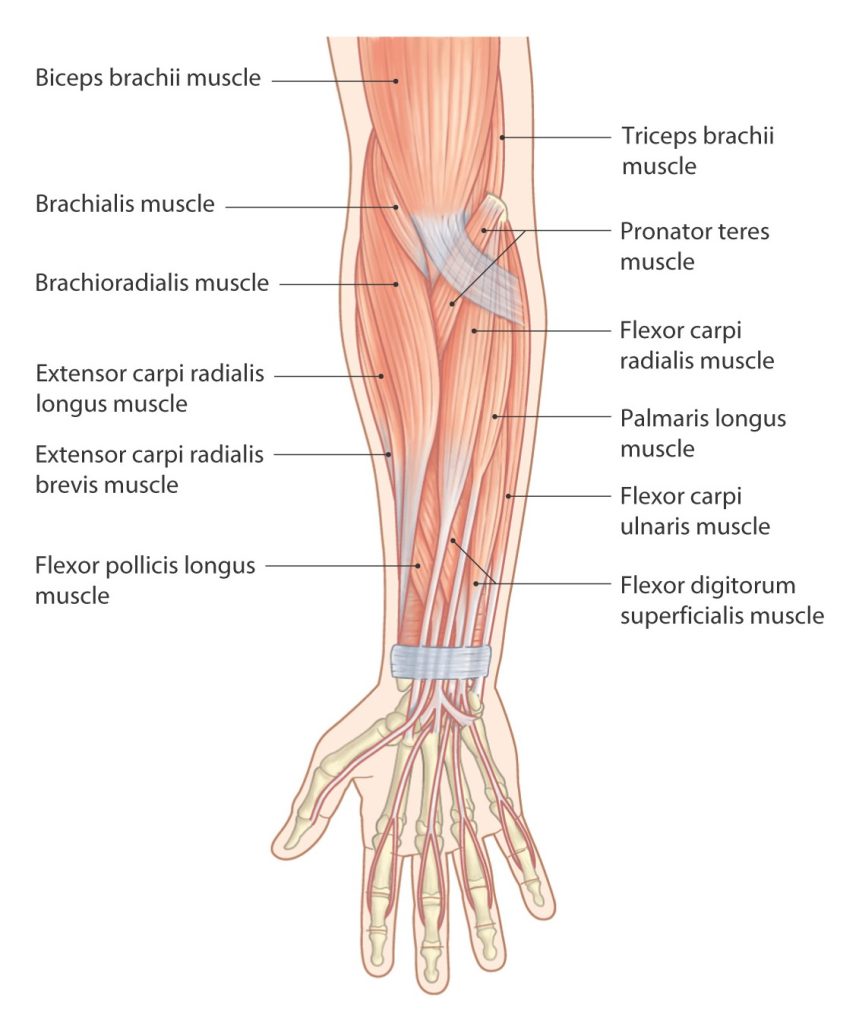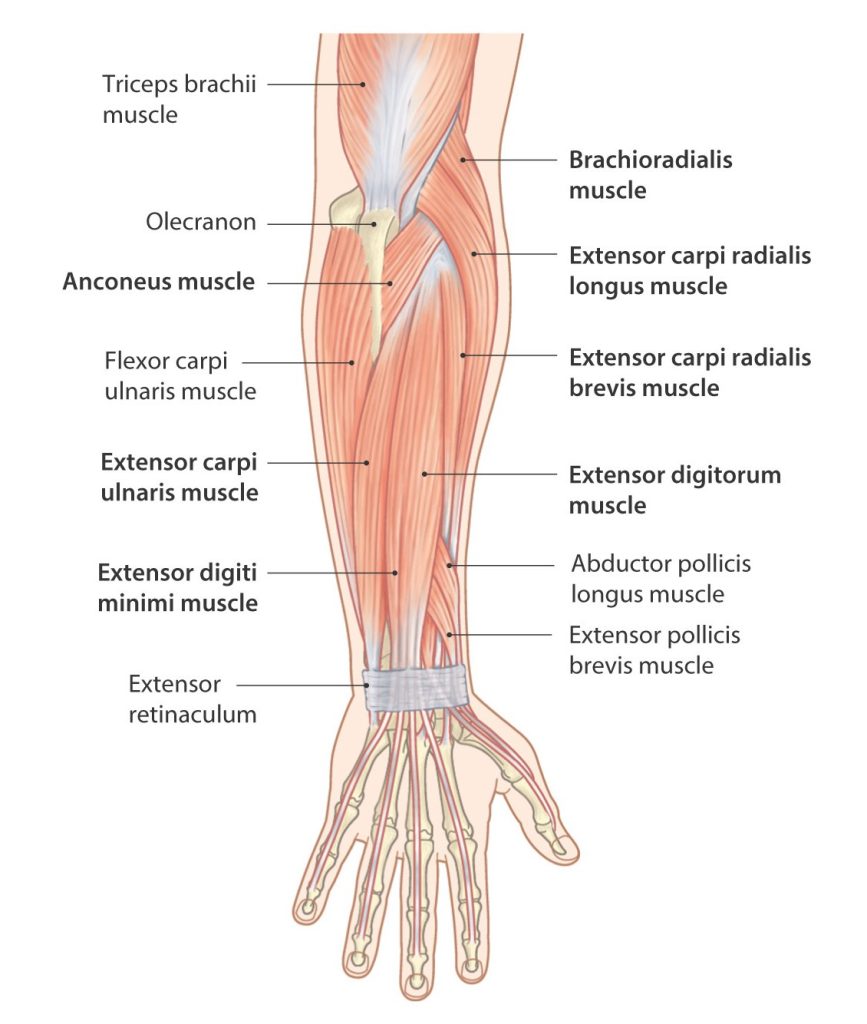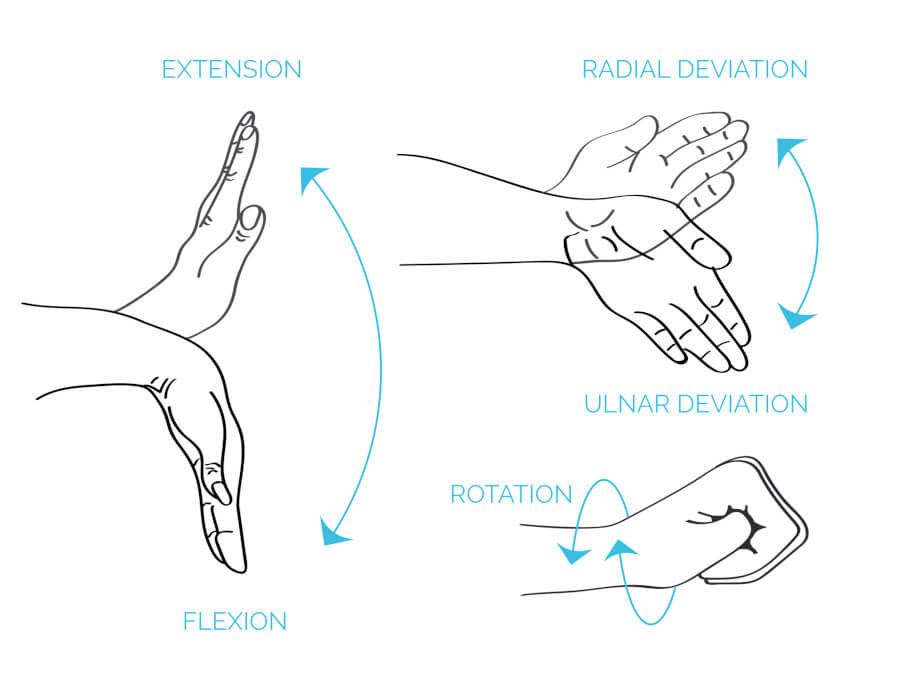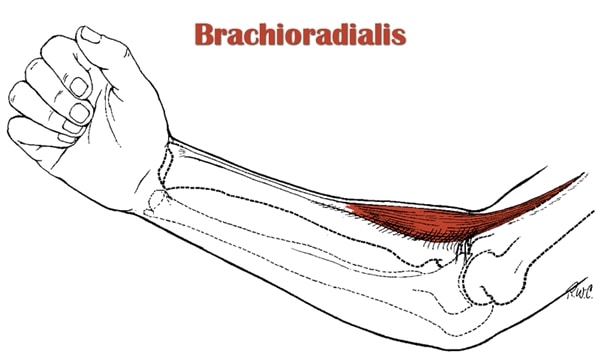Are you tired of having pipe-cleaner forearms? Do you want to get the biggest arms you possibly can? Want to open any pickle jar that comes your way? Well, you’ve come to the right spot! This guide will teach how to grow an often forgotten and overlooked aspect of arm training – the forearms. If you’re ready to turn into Popeye, all with just a dumbbell, keep reading below for the best forearm dumbbell exercises!
Forearm Anatomy
The forearms are some of the most intricate and sophisticated parts of the human anatomy. There are over 20 muscles in this area spanning the elbow and wrist with a multitude of different functions. You can divide the forearms into an anterior and posterior compartment. If you were to supinate your wrists, so that your palms are facing away from you, that would be the anterior side of the forearms. Flip them around, and that would be the posterior side.


These two compartments have opposing functions. With the anterior side responsible for wrist and finger flexion, and the posterior side doing the opposite with wrist and finger extension. Another important function of the forearms is supination and pronation of the wrist. Like I mentioned above, if you rotate your palms, so that they are facing away from you, that is supination. If your hands are in a chin-up grip you’re doing it right. Flip them around, so that they are facing you, and that is pronation. Basically, just get into a normal pull-up grip and you’re doing it right.
Lastly, there is a muscle in the forearm responsible for flexing the elbow. That is the brachioradialis found in the posterior compartment. This muscle will get plenty of stimulation during all of your regular bicep training, but if your forearms are a weak point, isolating this muscle is always a good idea and will definitely help to bring it up.


Now that you know how the forearm muscles work, keep reading to learn about the best exercises to target all these different areas, and finally get those Popeye forearms.
Forearm Dumbbell Exercises
1. Dumbbell Wrist Curls
Sit down on a bench and secure your elbow on your thigh. While holding the dumbbell in a supinated position with your palms facing the ceiling, flex your wrist and get a good contraction before extending your wrist down to get a good stretch on your flexor muscles. That would be one rep. Repeat until you complete all reps on one side before performing it again with the other forearm.
2. Dumbbell Wrist Extensions
Similar to the dumbbell wrist curls, sit down on a bench and secure your elbow on your thigh. While holding your elbow in a pronated position with your palms facing the floor, extend your wrist to get a good contraction in the extensors before reversing the motion and flexing the wrist to get a good stretch in the forearms. That would be one rep. Repeat until you complete all reps on one side before doing the other side.
3. Hammer Curls
While sitting down on a bench with your arms by your sides holding the dumbbells sideways, bring the dumbbells up by flexing your elbows to get a good contraction in your brachioradialis. Lower it with control back to the starting position and that would be one rep. Repeat until you complete the set. You can also perform the exercise standing as well for some variety. Whichever method you choose, you can modify the exercise by how you do the reps. You can work both arms simultaneously or you can alternate which arm is doing the work during each set (left arm, right arm, left arm, right arm, etc until the set is complete).
4. Zottman Curls
Seated Zottman Curls
While sitting down on a bench with your arms by your sides holding the dumbbell sideways, bring the dumbbells up in a supinated position (palms facing the ceiling) by flexing your elbows. Once you’re at the top position, pronate your arms (so your palms face the ground) and lower back to the starting position. That would be one rep. Continue the motion for the rest of the set.
Alternating Seated Zottman Curls
Like the seated Zottman curls, start by sitting down on a bench with your arms by your sides while holding the dumbbell sideways. Then, bring one dumbbell up in a supinated position (palms facing the ceiling) by flexing your elbow. Once you’re at the top position, pronate your arm (so your palm faces the ground) and lower back to the starting position. Repeat the motion for the other arm. That would be one rep. Continue the motion for the rest of the set.
5. Suitcase Carries
While holding the dumbbells at your sides and while maintaining a braced core, begin walking while focusing on keeping your core tight to prevent any motion at the spine. Take strong, intentional steps, and make sure that your core doesn’t flounder as you’re moving. Make sure to grip the dumbbells as hard as you can to get the greatest forearm activation. Keep taking steps until your forearms give out. While this exercise will really challenge your obliques, it also places a great demand on the forearms as they have to isometrically hold the heavy dumbbells.
Programming and Tips for Progression
1. Avoid training forearms directly before your back/pull days
Timing when it comes to forearm training is a very important thing to consider in your training program. One thing you want to avoid is training your forearms hard right before a back/pull day. This is because you don’t want your forearms to be a limiting factor and give out during your pulling movements.
For instance, most back programs will include exercises such as weighted pull-ups, barbell rows, dumbbell rows, some sort of hinging movement like a traditional deadlift, Romanian deadlifts, etc. If you train your forearms hard right before you perform these movements, your performance will suffer due to your forearms giving out rather than your back – which is the muscle you are trying to target and grow during these sessions.
Because of that, avoid training forearms directly before you train your back and train them after the session. If you have time constraints and can only find time to train your forearms before a back day, use straps during your back movements, so your forearms won’t hinder your pulling performance.
The best days to train your forearms are on your chest and leg days. Since these days don’t involve movements where your grip will give out before the target muscle does, this is a great time to get forearm work in. Do your wrist curls and extensions, along with the other exercises mentioned above, and you’ll be well on your way to getting rid of those pipe-cleaner forearms.
Another great time to train your forearms would be at the opposite time of the day when you normally train. For example, if you normally work out first thing in the morning, you could train your forearms at night and vice versa. If you work out at night, you could get your forearm work in during the morning. This way, you will be fresh during your normal training sessions to hit whatever muscle group you are working on that day without having to worry about your forearms affecting performance. The only downside to this approach is that you need to have the flexibility in your schedule to be able to train twice a day, which is a luxury many people can’t afford. On top of that, you need to at the very least have some dumbbells at home for you to even be able to do these exercises. While not feasible for many, if you have the time freedom and access to the equipment, this is a great approach for scheduling when to train your forearms.
2. Stick to high-rep sets
Like most isolation exercises, you should generally stick to a higher rep range, somewhere in the 10-20 rep range. Going anywhere below double-digit reps for a muscle group like the forearms isn’t tremendously useful for growth and should be reserved for specific use cases. If you’re someone like an arm wrestler or you want to become one of those guys who can close the Captains of Crush No. 4 (which is 365 lbs of resistance!), training in a low-rep range won’t be the greatest use of your time. Save the low-rep sets for your big compound movements like the squat or bench press. All in all, stick to the higher rep ranges like 10-15 reps or 15-20 reps for most of your working sets and you’ll be golden.
3. Short rest times
One of the great things about forearm training is how quickly you can train them. Because the forearms are a small muscle group, they don’t require a tremendous amount of time to recover, even between sets. You could literally rest 5-10 seconds after busting out a set of wrist curls and be ready to go for the next set. Unlike something like squats, where you may require anywhere from 2-5 mins of rest due to how demanding training a big muscle group like the quads is, you won’t need to do that with your forearms. Within 30 seconds between your sets, you’ll be ready to go and can get your forearm training done within 5-10 mins. So I don’t wanna hear the old “I don’t have time for that” excuse anymore for skipping out on forearms training. Everyone’s got five minutes, so get after it!
4. Progress by Adding Volume
When it comes to progressing your forearm training over time, my go-to method is doing more volume by adding sets. If you’ve never done forearm training before, 1-2 sets done 1-2 times a week of any of the exercises listed above will be more than enough to start. If you start finding that becoming too easy, add an extra set to each one of those days to keep making those gains. Once you’re at the point where you’re doing 3-5 sets for an exercise, you can consider adding another forearm exercise and repeating the process – starting low with the sets and adding more over time. This will ensure that your forearms are always being challenged over time and thus more gains.
Here’s what a sample program where you progress through volume could look like. I’m using the seated Zottman curl as the exercise of choice.
- Week 1: 1 set of 10-15 reps with a 30 lb dumbbell 1x a week
- Week 2: 1 set of 10-15 reps with a 30 lb dumbbell 2x a week
- Week 3: 2 sets of 10-15 reps with a 30 lb dumbbell 2x a week
- Week 4: 3 sets of 10-15 reps with a 30 lb dumbbell 3x a week
- Week 5: 4 sets of 10-15 reps with a 35 lb dumbbell 3x a week
So as you can see, progress by adding more sets to your training over time. This is the easiest and simplest way to make continual progress with your training. Once you’ve added sets for multiple weeks in a row, add more sets, as well as weight. Small weight increments for isolation movements like forearm training are all you need to always make your training challenging and effective.
Summary
So, there you have it. How to get those Popeye forearms, all with just a dumbbell. Incorporate the exercises listed above, add volume to those movements over time, follow the form tips and programming tips mentioned above, and you’ll get those forearms looking solid in no time. If you’re looking to take your training to the next level and get personalized one-on-one coaching from Coach Jay, check out my 10 Week Physique. You’ll receive a personalized training program, nutrition guide, and more! Check it out here!
